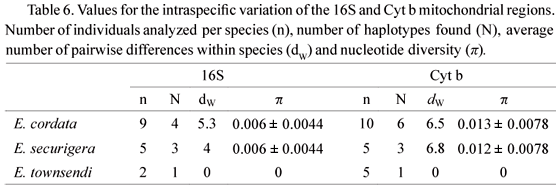Euglossine bees interact with more than 60 plant families of the Neotropical region. The richness and abundance of these bees have been intensively studied in different ecosystems using the methodology of capturing males with chemical baits. Females are poorly known for most of the species and morphological characters for their taxonomic classification have not yet been described. The purpose of this study was to use allozymes and restriction patterns of the mitochondrial regions 16S and Cyt b to identify species of Euglossa Latreille. Bees were collected while visiting Thevetia peruviana (Apocynaceae) flowers in five cities of the state of São Paulo, Brazil. Three Euglossa species were identified among the 305 individuals collected. Euglossa cordata (L.) was the only species found in all cities, while E. securigera Dressler and E. townsendi Cockerell were restricted to two and one cities respectively. EST-3 was a diagnostic marker, whereas ICD, MDH, ME and PGM were informative for species identification when used in combination. Restriction by VspI of the amplified 16S fragment differentiated the three species and showed intraspecific polymorphism for E. cordata and E. securigera. The Cyt b region showed distinctive patterns for E. townsendi but it was not possible to differentiate the other two species. Our results describe potentially useful genetic markers for the identification of Euglossa spp. at the species and group level.
Orchid bee; urban area; Thevetia peruviana; allozyme; PCR-RFLP

 Molecular identification of species of the Genus Euglossa Latreille (Hymenoptera: Apidae, Euglossini)
Molecular identification of species of the Genus Euglossa Latreille (Hymenoptera: Apidae, Euglossini)








